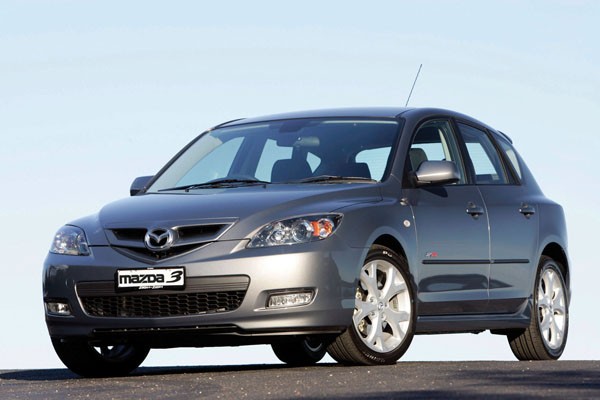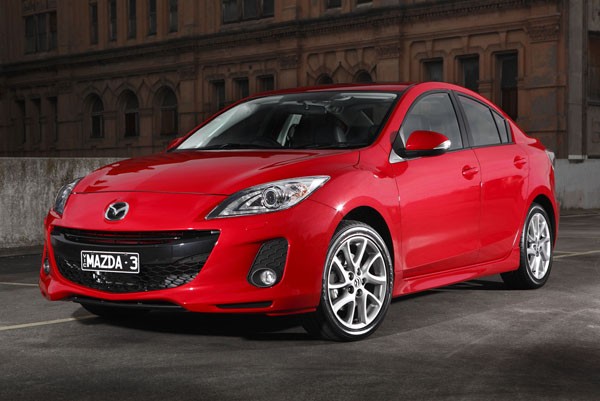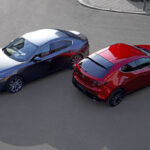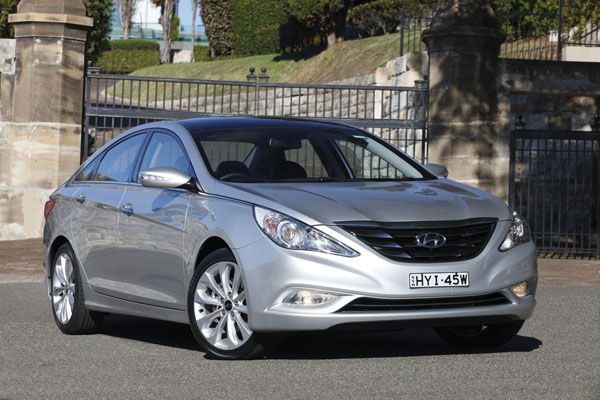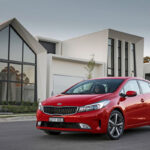By EWAN KENNEDY
CAPTIONS: A.
B.
C. 2011 Mazad3 SP25
BODY COPY
Mazda3 topped the overall sales race in 2011 and 2012 and already has a huge lead in the early days of 2014. Meaning there is a wide choice in the used-car scene, so take your time to find the best of the hundreds on sale at any one time.
Mazda3 first went on Australia in April 2004, replacing the long-running Mazda 323. An all-new Mazda3 was introduced in April 2009 and the third generation arrived here in January 2014. This report covers only the cars sold new up till the end of the second generation.
Excellent styling has a lot to do with Mazda3’s sales success, but the company’s well deserved reputation for building reliable, high-quality cars obviously plays a major part.
Though virtually identical under the skin, the Mazda3 four-door sedan and five-door hatchback bodies share few visible external panels. The sedan is comparatively conservative, the hatch comes with a semi sporting note.
Inside, the similarities are much more extensive. Interior space is good without being outstanding and you have to juggle the front seat legroom if you want to carry big adults in the back seat.
The sedan is longer than the hatch so has a larger boot, though the hatch enjoys the luxury of a more versatile load area. Try the two for size if you’re intending to use one as a family car. Both can work nicely if the kids are still in their preteen years.
An upgrade of the Mazda3 in July 2006 saw the body gain extra rigidity to reduce NVH (Noise, Vibration and Harshness) entry. There were also changes to the suspension settings, the tyre design as well as the fitment of additional under-bonnet and under-roof sound-deadening materials.
Mazda Australia had been in the forefront of safety for a long time in Australia so it came as no surprise that this mid-life upgrade also saw ABS fitted to all models in the range.
The standard Mazda3 models have a 2.0-litre four-cylinder petrol powerplant, the sporty Mazda3 SP23 has a 2.3-litre version of the same engine. Not only does the SP23 have more capacity, but also variable valve timing on the inlet valves to fatten out its torque graph.
With the 2009 model, the Mazda3 moved up in capacity to 2.5 litres as the SP25. It’s a nice powerplant with the sort of grunt keen drivers love.
Mazda introduced in new-tech SkyActiv engine in the Mazda3 SP20 in October 2011. However it’s a detuned version of the engine as there wasn’t sufficient space to fit the complex SkyActiv exhaust system under the bonnet.
Turbo-diesels with a capacity of 2.0 litres arrived in August 2007. Though it’s more economical than the petrol unit it hasn’t proven a real success in this country, partly because it’s only offered with a manual gearbox.
Transmission options in the standard Mazda3 petrol range prior to 2009 are five-speed manual and four-speed automatic with both engines. Each gained a ratio with the 2009 model, to six-manual and five-auto.
Mazda joined the hot-hatch brigade with an MPS (Mazda Performance Series) version of the Mazda3 in July 2006. The hot 2.3-litre, four-cylinder, turbocharged engine provides huge grunt.
Interestingly, the engineers opted to go only for front-wheel drive, not all-wheel drive, on the MPS. Torque steer, which could have made the car all but undriveable at times, is electronically tamed by a stability control system. However, maximum power and torque aren’t generally available in first and second gear, the engine only able to be boosted to its maximum in the final four ratios of the six-speed gearbox.
The only drawback with the Mazda3 MPS is that the designers inexplicably put the bonnet scoop out of sight under the bonnet. This problem was rectified with the all-new Mazda3 MPS in July 2009 which gained a very visible scoop as demanded by most owners of cars in this class.
Insurance costs for the Mazda3 MPS can be fearsome, so check on them before falling in love with the performance and chassis dynamics. Some companies charge a little more for the SP models, others class it in the same group as the rest of the non-MPS range. The cost of insurance in the standard models in the Mazda3 range is about average for this class.
Spare parts and servicing costs are about what you would expect from a car of this type. Home mechanics will find the Mazda3 isn’t overly complicated and that access to the underbonnet area isn’t as crowded as in some other cars of this size.
WHAT TO LOOK FOR
Check for crash repairs as poor work can seriously affect the resale value. Sight along the doors and look for ripples in the finish of the panels. Look out for tiny specks of paint on non-painted surfaces such as windows, badges and brightwork. These indicate a respray. If in doubt get a professional inspection – or find another car.
Make sure that the engine starts easily and idles smoothly from the moment it ticks over. Check for smoke from the exhaust at this early stage of the engine while it’s still warming up.
Look for severe tyre wear, particularly on the front tyres and especially on the high-performance variants off the Mazda3 – the SP and MPS.
A damaged interior and/or luggage area is likely to be a sign of an uncaring owner. Bored kids can do terrible things to the rear-seat area.
Be sure that the clutch takes up positively, gearchanges are all light and easy and that there is no sign of clutch slip.
An automatic transmission that has harsh changes and/or which changes at the wrong time, or refuses to change at all, may need to be serviced. Or even require major repairs.
CAR BUYING TIP
Before launching into tiny details of a car during your inspection, take a walk around looking for big defects and at its general condition.





